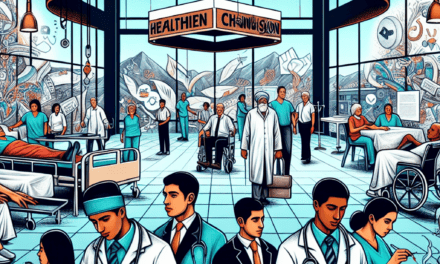-
Table of Contents
- The Role of Healthcare in Managing Pandemic Responses
- 1. Preparedness: Building Resilient Healthcare Systems
- 1.1 Infrastructure and Capacity Building
- 1.2 Workforce Training and Development
- 1.3 Surveillance and Early Warning Systems
- 1.4 Stockpiling Essential Supplies
- 1.5 International Collaboration and Cooperation
- 2. Response: Mobilizing Healthcare Resources
- 2.1 Rapid Deployment of Medical Personnel
- 2.2 Establishing Field Hospitals and Temporary Facilities
- 2.3 Implementing Triage and Prioritization Protocols
- 2.4 Ensuring Continuity of Care for Non-Pandemic Patients
- 2.5 Coordinating with Public Health Authorities
- 3. Communication: Informing and Engaging the Public
- 3.1 Developing Clear and Consistent Messaging
The Role of Healthcare in Managing Pandemic Responses

The COVID-19 pandemic has underscored the critical role that healthcare systems play in managing global health crises. As the world continues to grapple with the challenges posed by pandemics, understanding the multifaceted role of healthcare in pandemic response is essential. This article explores the various dimensions of healthcare’s involvement in pandemic management, including preparedness, response, communication, innovation, and recovery. By examining these aspects, we can glean valuable insights into how healthcare systems can be better equipped to handle future pandemics.
1. Preparedness: Building Resilient Healthcare Systems
Preparedness is the cornerstone of effective pandemic management. Healthcare systems must be resilient and adaptable to respond swiftly to emerging health threats. This section delves into the strategies and measures that healthcare systems can implement to enhance their preparedness for pandemics.
1.1 Infrastructure and Capacity Building
One of the primary components of preparedness is ensuring that healthcare infrastructure is robust enough to handle surges in patient numbers. This involves investing in hospital facilities, increasing the number of intensive care units (ICUs), and ensuring an adequate supply of medical equipment and personal protective equipment (PPE).
For instance, during the COVID-19 pandemic, countries with well-developed healthcare infrastructure, such as Germany, were able to manage patient loads more effectively than those with limited resources. Germany’s high number of ICU beds per capita played a crucial role in its ability to provide care for critically ill patients.
1.2 Workforce Training and Development
A well-trained healthcare workforce is essential for effective pandemic response. This includes not only medical professionals but also support staff who play a vital role in patient care and hospital operations. Continuous training programs and simulations can help prepare healthcare workers for the unique challenges posed by pandemics.
For example, Singapore’s healthcare system emphasizes regular training and drills for its medical staff, ensuring they are well-prepared for emergencies. This approach has contributed to the country’s ability to manage outbreaks efficiently.
1.3 Surveillance and Early Warning Systems
Early detection of infectious diseases is crucial for preventing widespread outbreaks. Healthcare systems must invest in surveillance and early warning systems to identify potential threats quickly. This includes monitoring disease patterns, collecting data, and collaborating with international health organizations.
The World Health Organization’s (WHO) Global Outbreak Alert and Response Network (GOARN) is an example of a collaborative effort to enhance global disease surveillance. By sharing information and resources, countries can respond more effectively to emerging health threats.
1.4 Stockpiling Essential Supplies
Stockpiling essential medical supplies, such as vaccines, antiviral drugs, and PPE, is a critical aspect of preparedness. During pandemics, supply chains can be disrupted, leading to shortages of vital resources. By maintaining strategic reserves, healthcare systems can ensure that they have the necessary supplies to respond to emergencies.
The Strategic National Stockpile in the United States is an example of a national reserve of medical supplies designed to provide support during public health emergencies. This stockpile played a crucial role in supplying PPE and ventilators during the COVID-19 pandemic.
1.5 International Collaboration and Cooperation
Pandemics are global challenges that require international cooperation. Healthcare systems must work together to share information, resources, and expertise. Collaborative efforts can enhance preparedness and response capabilities, ultimately leading to better outcomes for affected populations.
The Global Health Security Agenda (GHSA) is an international partnership that aims to strengthen global health security by improving countries’ capacities to prevent, detect, and respond to infectious disease threats. By fostering collaboration, the GHSA helps build a more resilient global health system.
2. Response: Mobilizing Healthcare Resources
Once a pandemic is underway, healthcare systems must mobilize their resources to respond effectively. This section explores the various strategies and actions that healthcare systems can take to manage the immediate impact of a pandemic.
2.1 Rapid Deployment of Medical Personnel
During a pandemic, the demand for healthcare services can quickly overwhelm existing resources. Rapid deployment of medical personnel, including doctors, nurses, and support staff, is essential to meet the increased demand for care.
In response to COVID-19, many countries implemented measures to increase the availability of healthcare workers. For example, Italy recruited retired doctors and medical students to bolster its healthcare workforce during the peak of the pandemic.
2.2 Establishing Field Hospitals and Temporary Facilities
To accommodate the surge in patients, healthcare systems may need to establish field hospitals and temporary facilities. These facilities can provide additional capacity for treating patients and help alleviate the burden on existing hospitals.
During the COVID-19 pandemic, the United Kingdom’s National Health Service (NHS) set up several temporary hospitals, known as Nightingale Hospitals, to provide additional capacity for COVID-19 patients. These facilities were equipped with the necessary medical equipment and staffed by healthcare professionals.
2.3 Implementing Triage and Prioritization Protocols
In situations where resources are limited, healthcare systems must implement triage and prioritization protocols to ensure that patients receive the most appropriate care. This involves assessing patients’ conditions and determining the level of care they require.
For example, during the H1N1 influenza pandemic, healthcare systems developed triage protocols to prioritize patients based on the severity of their symptoms and the likelihood of recovery. These protocols helped ensure that resources were allocated effectively.
2.4 Ensuring Continuity of Care for Non-Pandemic Patients
While responding to a pandemic, healthcare systems must also ensure continuity of care for patients with non-pandemic-related health issues. This requires balancing the needs of pandemic patients with those of individuals requiring routine medical care.
Telemedicine has emerged as a valuable tool for maintaining continuity of care during pandemics. By providing remote consultations, healthcare providers can continue to care for patients with chronic conditions while minimizing the risk of infection.
2.5 Coordinating with Public Health Authorities
Effective pandemic response requires close coordination between healthcare systems and public health authorities. This collaboration ensures that healthcare providers have access to the latest information and guidance on managing the pandemic.
During the COVID-19 pandemic, the Centers for Disease Control and Prevention (CDC) in the United States worked closely with healthcare providers to disseminate information on infection control measures, testing protocols, and treatment guidelines. This coordination helped ensure a consistent and effective response to the pandemic.
3. Communication: Informing and Engaging the Public
Clear and effective communication is vital during a pandemic. Healthcare systems play a crucial role in informing and engaging the public, ensuring that individuals have access to accurate information and understand the measures they need to take to protect themselves and others.
3.1 Developing Clear and Consistent Messaging
During




